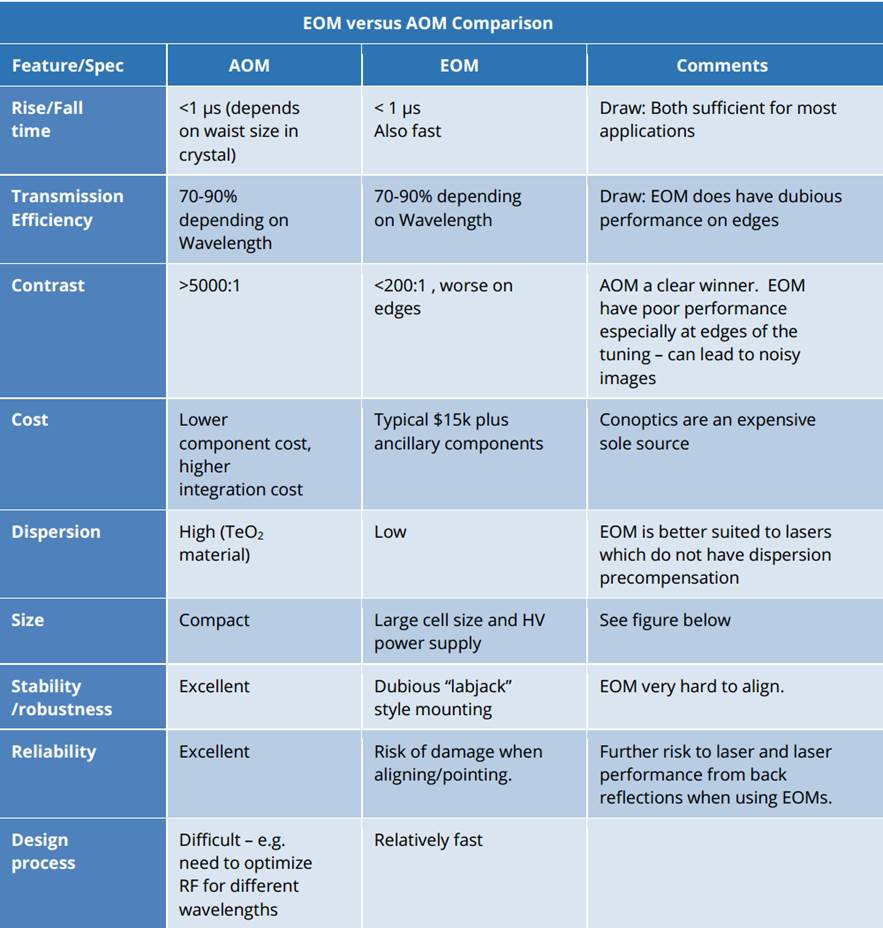Laser power modulation: EOMs and AOMs

Fast laser power modulation in 2p systems is typically done with a Pockels cell. Conoptics sells one that is optimized for common Ti:Sapph systems, and that’s what many people end up using.
Pockels cells are a type of electro-optical modulator (EOM).
Another family of devices for modulating laser power are acousto-optical modulators (AOM).
There was a discussion of EOM vs AOM back in October. Click through to read the thread.
Pros and cons AOM vs. pockels cell for 2P microscopy: Does anyone have experience with AOMs for resonant scanning turnaround blanking?
— H.A. Obenhaus (@Neuroballs) October 18, 2017
In some correspondence with Coherent, they sent me the chart above, which summarizes some of the differences between AOMs and EOMs. It’s useful, even if some of the “weaknesses” of EOMs are a bit exaggerated (aligning EOMs isn’t that difficult).
Hat tip to Evan Raba and Darryl McCoy at Coherent

I have decent experience with two manufacturers of 2P microscopes. Prairie and Olympus. The former use Pockels cells. With help from Coherent and Spectra-Physics we tested the effects of the Pockels on the pulse width. For the Verdi-Mira system we found that the pulse width increased from 100 to 140 fs (measured on the light table). For the HP MaiTai we found we could fully compensate the stretching of all the glass – 65 fs was measured coming out of the objective (20x lens). My understanding is that Olympus really needed this type of laser to make their 2PM work well. They use an AOM, which adds a huge amount to pulse width. (Perhaps someone else knows the exact number?). One thing that needs to be mentioned is that Pockels zero is wavelength dependent, so you need to fiddle a bit with this. But we use with normal scanning and res galvo with no issues. Alignment is not a problem with Pockels, and they are more robust than people say.
In what sense is the EOM hard to align? I always use the supplied alignment tool and then install the EOM and perform minor tweaks to lower the required bias voltage. Generally it’s pretty straightforward. I don’t see what is dubious about the labjack: I’ve never seen one need re-alignment once set up.
Cons not listed in your table are:
1) EOM crystals degrade over time due to the applied voltage, so it’s important to turn off the amplifier when not in use. Once I had replace an EOM that was about 7 years old (IIRC) because it had developed a poor extinction ratio and was no longer stable.
2) EOMs are temperature dependent and so you might see changes in laser power in rooms with poor temperature regulation.
3) Some people have reported that EOMs are prone to electrical interference, but I’ve not noticed that myself.
It’s not our table. Like we said in the post, the table is from Coherent, and is clearly sales material biased towards AOMs with some exaggerations. Like you, we specifically noted that alignment of EOMs is not that hard. Some other parts of the table are a fair, quick summary of the differences– e.g., contrast, dispersion, wavelength dependence (under design process),
Thanks for the note on aging in EOMs, and their temperature dependence. Are AOMs less dependent on temperature?